
The 2018 FIFA World Cup was the greatest show on earth, featuring the swanky surrounds of the Luzhniki Stadium in Moscow - the site where Edwin van der Sar’s ecstasy in the Manchester United goal ten years ago was overshadowed by the overflowing tears from the eye of an Englishman who had good reason to be out on the pitch in his full kit.
Ten years on, the Luzhniki and the whole of Russia hosted the biggest spectacle in the footballing world, but the love of Edwin van der Sar’s life - the Netherlands National Football Team, were not around to play any part in that tournament.
A FIFA World Cup without the Dutch - in many an outrageous orange kit, with many an outrageous player - did not quite seem right. Yet, in the context of Dutch football, it is about as right as Manchester United scoring a late winner at a rain-drenched Old Trafford.
The Netherlands do not like logic. They do not play by the common man’s logic. Instead, the Netherlands have their own logic - which is always black or white. Maybe, in this case, orange is just the new black.
The Total Football of Michels and Cruyff and Neeskens, the sheer melodrama of the rockstars that were van Basten, Gullit and Rijkaard, the romance of the hairless hair-raising Sneijder and Robben, and the evolution from Total Football to Total Shambles was pretty much complete.
For a start, let’s compress Dutch Football to just the last eight years before the World Cup in Russia.
2010-2018: Dutch Football to a T
The 2010 World Cup in South Africa was a dream nearly fulfilled. From bald-headed magnificence to Kung-fu kicking chutzpah, that team had it all - well maybe not the flamboyance of the 20th-century teams.
That team also had the absolute camel-brained resolve of a manager that used every resource he had to create a team that could not be beaten.
The maverick unpredictability of Gregory van der Wiel, the dogged steeliness of Joris Mathijsen, the pre-Everton Johnny Heitinga, who could actually defend, and 35-yard thunderbolt-hitting Giovanni van Bronckhorst sat behind the free spirit of Nigel de Jong and the apex predator that was Mark van Bommel.
The free-spirit was freely winning tackles, freely allowing Wesley Sneijder to do his thing, freely allowing Mathijsen and Heitinga breathing space, freely taking swipes at other grown men’s chests! The apex predator was cleanly swallowing anything and everything that came his way in midfield.
The romance of Dirk Kuyt’s never-ending battery on his Duracell-powered engine or the grenade launcher attached to Robin van Persie’s left foot still paled in comparison to the romance of two follicly-challenged men who seemed like they could make even the most annoying of vuvuzelas play aesthetically pleasing tunes.
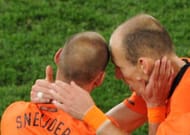
Wesley Sneijder and Arjen Robben were still around when the Total Shambles happened.
They were around when two years after making the final of a World Cup, the Dutch contrived to give Michael Krohn-Dehli his big moment on the world stage. A certified disaster in Euro 2012 was not on expected lines, but hey, what do you expect with the Netherlands? How can you make educated predictions out of such a footballing nation?
In 2014, came another wild Dutch ride - courtesy Louis van Gaal - with that black folder in all its glory.
The 60,000-capacity Estadio Fonte Nova in Salvador had replaced Johannesburg’s Soccer City as the venue for the second straight World Cup meeting for the Oranje against Spain.
The pain of 2010 was not exorcized, but the class of 2014 had a result for the ages. The victim of the now-famed Kung-fu kick, Xabi Alonso, had not erred from the penalty spot to put the Spaniards on their way.
He did have margin to err, such was poor Jasper Cillessen’s luck when faced with a dead ball twelve yards away from him. That luck would go on to play a defining role in the Dutch World Cup campaign.
But then came what was the most beautifully-Dutch 60 minutes of football. Daley Blind was a man possessed on the left flank, Robin van Persie had a few springs attached to his boots, Arjen Robben ran at 5th gear throughout. In the process, the Spain of Casillas and Ramos, Xavi and Iniesta, had been thoroughly smashed. Five goals to one. Five.
After Chile, Australia and Mexico had been dealt with, in front of the Dutch stood tiny Costa Rica. What chance did they have when the mighty all-conquering bullfighters were pummeled into submission?
They had a chance, with an inspired Keylor Navas in their goal summoning all his powers to make the sticks between which he stood his best friends.
Poor Jasper though. He couldn’t catch a cold - erm, in this case, a penalty - if he tried. So, on came Tim Krul, looking to summon the force of all those Geordies that so adored him at that point.
It was a move that looked out of place, but one that fitted into Krul’s Newcastle DNA. After all, the Gallowgate End is often decorated with magnificent topless men, desperate to tell the world that miserable weather in the northeast of England was not enough to contain true Geordie spirit.
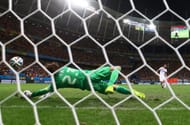
Krul was a man emboldened. Krul was a man doing his own things on his Louis van Gaal-presented stage.
A warm tropical night in Salvador isn’t the same as a typical winter afternoon up on Tyneside, but Tim Krul owned this stage - at least he behaved like he owned the stage.
He was a Jedi - using his mind to make balls hit by Costa Rican boots thud into his gloves and away from goal.
Poor Jasper, again. In the semi against a Messi-led Argentina, he had to stay on in goal for the shootout, there was no Jedi, there was no mastermind who thought his Jedi was needed again.
If a Dutch football fan was given a choice to stop time, that July night in Brasilia - when a sombre host nation faced another humbling on top of their greatest ever embarrassment to give the Dutch a third-place finish - would be the reply streaming through most lips.
Van Gaal was gone, he wanted his own experience of a rain-drenched Old Trafford.
Guus Hiddink came, Guus Hiddink failed. Danny Blind came (why?), Danny Blind failed. Dick Advocaat came (why?), Dick Advocaat failed.
Phew, that was eight years of football, but imagine a country drenched in such footballing history. Netherlands, to the T.
Total Football - They really were as infatuating as they were infuriating.
The absolute emergence of Dutch football on the world stage came in the late 60s, the early 70s, with Rinus Michels and Johan Cruyff pioneering Total Football, that defined the sides that went on to make the final in both the 1974 and 1978 World Cups.
But in captivating the world during those two tournaments, the Dutch eventually ended up like they have at most big tournaments since.
The foundations for those two exhilarating World Cup campaigns were laid in Amsterdam, as Michels set about putting his footprint on Ajax, to enable them to dominate European football.
But the enormous success of Total Football, exemplified by that Ajax team which won three European Cups in succession from 1971 to 1973, sometimes is overshadowed by the one game that ended in heartbreak. The Netherlands’s loss at the 1974 World Cup final was despite Total Football, not because of it.
It was also because the Netherlands do not like common logic, they have their own.
When Argentina were swatted aside, Brazil comfortably dealt with in the semifinal, there was nobody who would’ve dared posed a question to Michels or to Cruyff about their methods.
When the West Germans, armed with Beckenbauer and Muller, Hoeness and Vogts came face to face with the Dutch in Munich, it promised to be a game that would be talked about for years and years.
The first minute of the final showcased Total Football, in all its glory. It showed Johan Cruyff in his total glory as well. The no. 14 picked up the 15th pass of the game, and decided that he was going to make Beckenbauer and co. groove to his tunes. Swish, boing, bang, three defenders were out of the way, left behind by the magic that lay in Cruyff’s feet. As he entered the penalty area, Hoeness did what he felt he had to, sliding in, bringing Cruyff down and conceding a penalty.
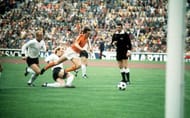
Johan Neeskens made no mistake from the spot, and the Dutch were on their way, before the Germans could even touch the ball. Total.
But as the game wore on, the Germans settled in, and they had a penalty of their own, which Paul Breitner converted, before Gerd Muller contrived to break Dutch hearts.
In 1978, there was no Cruyff, Ernst Happel had taken over from Michels, but the Netherlands way remained. Argentina were waiting in the summit clash at the Estadio Monumental.
Mario Kempes continued in what was really his World Cup, scoring two goals in a 3-1 win for La Albiceleste.
Those two World Cups showcased as gloriously Netherlands as Netherlands could be. The art of consistently finding themselves on the big stage and not completely owning that stage began to become an intrinsic part of Dutch football.
They really were as infatuating as they were infuriating. Maybe they still are infuriating, but they’re not nearly as infatuating now, as they once were.
If ‘74 and ‘78 was Total Football in all its glory, the next few years were spent living in the shadow of Total Football. The pioneers of it had retired, the squad wasn’t the same anymore, and in 1980, the Dutch found themselves not even qualifying for the European Championships.
Qualification for the 1982 World Cup and Euro ‘84 were also unachieved. Qualification for Euro ‘84 was a close-run affair, with the Dutch only missing out on the tournament, on the virtue of Spain having scored two more goals than them in qualifying.
The 1986 World Cup also didn’t have Dutch presence, with close neighbours Belgium beating them in a playoff.
That playoff tie was once again a case of so near yet so far for the Dutch. Belgium had won the first leg 1-0 in Brussels, but the Dutch were by no means out of it, not with a raucous Rotterdam lying in wait.
They went 2-0 up too, what could go wrong? As it turned out, everything could. An 89th minute goal for the Belgians meant it was them who would take the flight to Mexico and not the Dutch.
For the man considered a father-figure in Dutch football, enough was enough. Michels was back by the time the Dutch had set foot in West Germany for Euro ‘88.
They had lost their opening game to the USSR. But then the Dutch came alive. Sir Bobby Robson’s England were swatted away, the Republic of Ireland were dealt with. The Dutch would play the semifinal.
Euro ‘88: The story of one night in Hamburg
The semifinal of the European Championship. Against West Germany. At Hamburg, in West Germany. The scars of ‘74 were still fresh, Michels was never going to let his players forget the scars of ‘74.
Lothar Matthaus had given the Germans the lead from the spot, only to see the favour returned in kind by Ronald Koeman, before Marco van Basten sent the Dutch into the final.
Revenge had been achieved, and the Dutch had to show the Germans that revenge had been achieved.
So Ronald Koeman, not yet waxing lyrical about Liverpool while managing Everton, decided that he was going to rub it in. After having swapped shirts with Olaf Thon, he proceeded to move towards the crowd and gesture like he was cleaning his backside with that shirt.
Needle. Dutch needle. The Germans were enraged, but did Koeman give a rat’s backside? Based on his own admission later in his life, he probably did, but at that point, who cared? Not Michels. Not Koeman. Not the whole of the Netherlands.
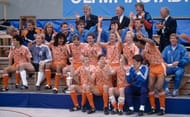
The final against USSR began in the most perfect way for the Dutch. The big locks, no. 10, captain’s armband on show, Ruud Gullit got that famed head to the ball and gave them the lead.
But no one, not even the greatest fortune-teller, could have told you what would come next. On the right side of the penalty area, a long ball was falling at the feet of a no.12, blessed with outstanding technique.
Common sense dictated the no.12 would bring the ball down and try to put it into the box. But remember, this is the Netherlands, they do not like common sense or common logic.
So Marco van Basten, that bloody no.12, decided that he’d look for the side-netting in the far-corner. He found the side-netting in the far corner with the most outrageous volley, which had Soviet ‘keeper Rinat Dasayev almost begging for mercy.
He wasn’t finding that with van Basten, with Gullit or with Michels. The Netherlands had just won their first, and to date only, major trophy.
To hell and back again
For a country that blessed with tradition, how did it come to the ignominy since Brazil 2014, though? Saying that it was expected just because it is the Netherlands is taking the easy way out.
Much like England’s golden generation of the early 2000s, the Netherlands had one too. The van Nistelrooys, the van Persies, the Sneijders, the Robbens of the world.
But in the last few years, there was a talent gap too big to bridge. The stars have already faded or are fading into the twilight of their career, but now they have the talent to bridge that gap.
All of them, young, all of them wanting to make their mark on a Dutch nation that wants a renaissance. The man tasked with leading that renaissance? In 30 years, Ronald Koeman went full circle. From enraging Hamburg with an offensive gesture, he was back for the Dutch 30 years later, this time in the dugout. It was only poetic that the first real sign of the Dutch phoenix came against Germany, against whom have come the most famed Dutch battles.
But perhaps most tellingly, the Netherlands didn’t anymore have the swagger, the style and the acumen those teams of the late 20th century had. Those teams were the envy of the world, there were managers all across Europe who wanted to play the way Rinus Michels’s Netherlands team played.
Heck, the greatest club team of this millennium has been built on Michels’s ideals, left there by his most coveted disciple. Barcelona, in its current form, owes everything to Johan Cruyff. The all-conquering Spanish teams from 2008 to 2012 owed a lot of their success to Barcelona. The method was still alive, it could still be used to bring success. But somehow, the Netherlands were not using that method anymore.
The intensity, the imagination, the sheer joy of watching was gone. The football is so dead, many a man had written his eulogy for Dutch football.
But come 2022, in that burgeoning city of Doha, wise men would have told you that the Netherlands won’t be there, again.
But Koeman is armed to prove them wrong. Armed with the laid-back magnificence of his skipper Virgil van Dijk. Armed with the maturity-beyond-his-years of Matthijs De Ligt. Armed with the magnificence of Frenkie De Jong. Armed with the versatility of Gini Wijnaldum. Armed with the explosiveness of Memphis Depay and the armada of young wingers whose pace can make defenders look rather silly.
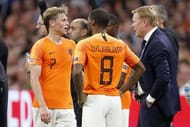
But they are the Netherlands. They could rise from these ashes, only to cloud themselves in a whole new set of ashes.
In 44 years, the Netherlands have evolved. They had gone from Total Football to a total shambles. In four years, don’t blame anyone for not telling you they could be totally mesmerizing again. It’s that word, nonsense.
